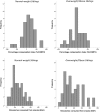Caloric compensation and eating in the absence of hunger in 5- to 12-y-old weight-discordant siblings
- PMID: 22854400
- PMCID: PMC3417216
- DOI: 10.3945/ajcn.112.037952
Caloric compensation and eating in the absence of hunger in 5- to 12-y-old weight-discordant siblings
Abstract
Background: An impaired ability to compensate for calories and increased eating in the absence of hunger (EAH) has been associated with increased energy intake and weight gain in unrelated children.
Objective: The aims of this study were to compare caloric compensation [the percentage compensation index (%COMPX)] and EAH in weight-discordant siblings aged 5-12 y.
Design: In a crossover, behavioral genetics design, 47 same-sex sibling pairs (53% female, 55% full siblings) were served dinner once a week for 3 wk. Across conditions, siblings were served the same dinner, but 25 min before dinner, they either consumed in full or did not consume 1 of 2 preloads that varied in energy density (ED; 0.57 or 0.97 kcal/g). On the day when no preload was consumed, EAH was assessed after dinner and defined as the number of calories consumed from snacks.
Results: Overweight/obese siblings undercompensated [%COMPX: -48.8 ± 56.3 (mean ± SEM)] and therefore overate after the high-ED preload, whereas normal-weight siblings showed accurate compensation (%COMPX: 101.3 ± 51.9; P = 0.03). Furthermore, overweight/obese siblings consumed 34% more calories (93 kcal) in the absence of hunger than did normal-weight siblings (P = 0.01). Within-pair resemblances for %COMPX and EAH were stronger for full siblings (P < 0.049) than for half siblings (P > 0.23).
Conclusions: An impaired ability to regulate short-term energy intake, which includes incomplete adjustment for calorie differences in a preload and eating when satiated, may represent a behavioral phenotype for obesity in children. Future studies should test whether teaching children to focus on internal satiety cues may prevent at-risk children from overeating.
Trial registration: ClinicalTrials.gov NCT01598389.
Figures



Similar articles
-
Impact of adiposity, age, sex and maternal feeding practices on eating in the absence of hunger and caloric compensation in preschool children.Int J Obes (Lond). 2015 Jun;39(6):925-30. doi: 10.1038/ijo.2015.30. Epub 2015 Mar 17. Int J Obes (Lond). 2015. PMID: 25777357
-
Caloric compensation in preschool children: Relationships with body mass and differences by food category.Appetite. 2017 Sep 1;116:82-89. doi: 10.1016/j.appet.2017.04.018. Epub 2017 Apr 19. Appetite. 2017. PMID: 28432007 Free PMC article. Clinical Trial.
-
Caloric compensation and appetite control in children of different weight status and predisposition to obesity.Appetite. 2020 Aug 1;151:104701. doi: 10.1016/j.appet.2020.104701. Epub 2020 Apr 11. Appetite. 2020. PMID: 32289325 Free PMC article.
-
Inter-individual differences in children's short-term energy compensation: a systematic review and meta-analysis.Am J Clin Nutr. 2023 Dec;118(6):1202-1213. doi: 10.1016/j.ajcnut.2023.09.013. Epub 2023 Sep 25. Am J Clin Nutr. 2023. PMID: 37758060 Free PMC article.
-
Weight discordant siblings' ability to reduce energy intake at a meal as compensation for prior energy intake from sugar-sweetened beverages (SSBs).Nutr Health. 2021 Mar;27(1):59-67. doi: 10.1177/0260106020960990. Epub 2020 Oct 12. Nutr Health. 2021. PMID: 33045926 Free PMC article. Clinical Trial.
Cited by
-
Does milk matter: Is children's intake affected by the type or amount of milk served at a meal?Appetite. 2016 Oct 1;105:509-18. doi: 10.1016/j.appet.2016.06.022. Epub 2016 Jun 21. Appetite. 2016. PMID: 27338218 Free PMC article. Clinical Trial.
-
Prenatal predictors of objectively measured appetite regulation in low-income toddlers and preschool-age children.Pediatr Obes. 2019 Nov;14(11):e12554. doi: 10.1111/ijpo.12554. Epub 2019 Jun 18. Pediatr Obes. 2019. PMID: 31215152 Free PMC article.
-
Appetite Self-Regulation in Childhood: A Narrative Review and Conceptual Model of Processes and Mechanisms With Implications for Research and Practice.Nutr Rev. 2025 Sep 1;83(9):1784-1799. doi: 10.1093/nutrit/nuae220. Nutr Rev. 2025. PMID: 39841603 Free PMC article.
-
Cost Effectiveness of Calorie Labeling at Large Fast-Food Chains Across the U.S.Am J Prev Med. 2024 Jan;66(1):128-137. doi: 10.1016/j.amepre.2023.08.012. Epub 2023 Aug 14. Am J Prev Med. 2024. PMID: 37586572 Free PMC article.
-
Examining the Role of Food Form on Children's Self-Regulation of Energy Intake.Front Nutr. 2022 Feb 9;9:791718. doi: 10.3389/fnut.2022.791718. eCollection 2022. Front Nutr. 2022. PMID: 35223945 Free PMC article.
References
-
- Whitaker RC, Wright JA, Pepe MS, Seidel KD, Dietz WH. Predicting obesity in young adulthood from childhood and parental obesity. N Engl J Med 1997;337:869–73 - PubMed
-
- Dunn J, Plomin R. Why are siblings so different? The significance of differences in sibling experiences within the family. Fam Process 1991;30:271–83 - PubMed
-
- Allison DB. The use of discordant sibling pairs for finding genetic loci linked to obesity: practical considerations. Int J Obes Relat Metab Disord 1996;20:553–60 - PubMed
-
- Birch LL, Davison KK. Family environmental factors influencing the developing behavioral controls of food intake and childhood overweight. Pediatr Clin North Am 2001;48:893–907 - PubMed
Publication types
MeSH terms
Associated data
Grants and funding
LinkOut - more resources
Full Text Sources
Other Literature Sources
Medical

